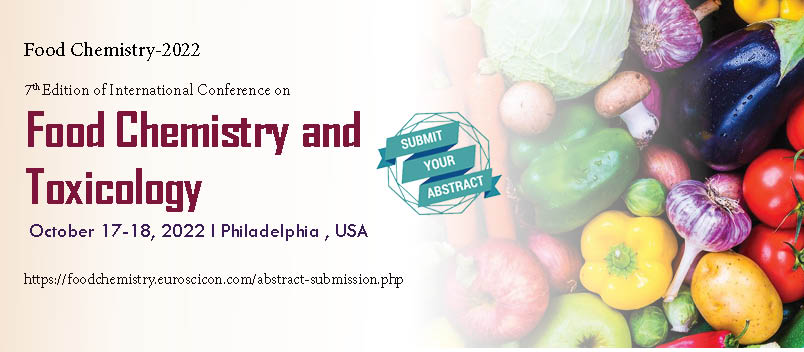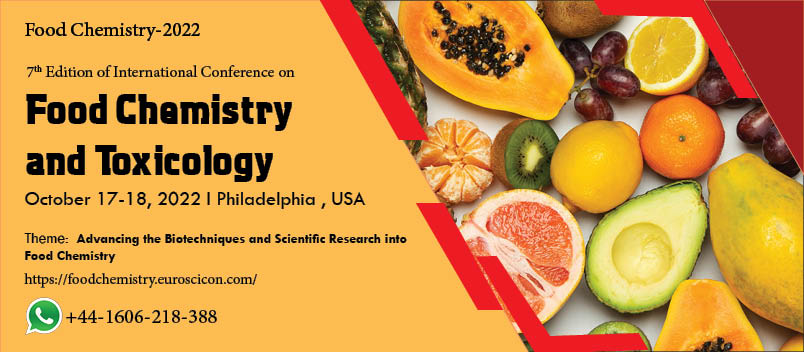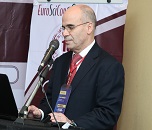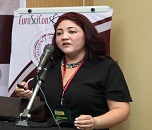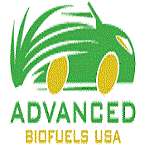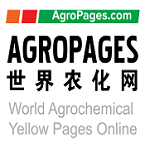food chemistry 2022
ABOUT CONFERENCE
EuroSciCon is back with the 7th Edition of International Conference on Food Chemistry and Toxicology on October 17-18, 2022 at Philadelphia, USA and we focus on the recent advancements & its applications in Agriculture & Food Chemistry. Food Chemistry-2022 includes prompt Keynote presentations, Oral talks (Speaker forum and Young research forum), and Poster presentations, Workshops, Symposium and Exhibitions.
Food Chemistry-2022 is a global overview which will provide an international platform for the discussion of agriculture & food Chemistry. This event gathers all the eminent persons, professors, scientists, doctors, medical practitioners, health workers, professionals, students, and industrialists all over the world to exchange their ideas, researches and their experiences. It also brings together persons particularly interested in the chemistry of agricultural and food products, both raw and finished; to foster programs of general papers and symposia on special topics dealing with this field of chemistry; to promote such other activities as will stimulate activity in and emphasize the importance of research in agricultural and food chemistry. Our conference provides quality, timely Symposium at International Conference on Agricultural & Food Chemistry.
Why to attend our conference
This event will provide an opportunity to build and expand your network with various people and gives chance to make collaboration with other universities and research labs. It also helps you to meet the experts in the relevant field of study. It gives the access to novel instruments in the market. This conference plays a major role in your business development and maximizes the profit.
Goals
- Develop focused and timely programs, products and services that engage those involved in agriculture, food chemistry, and related fields.
- Enhance communication and market our programs, products, and services more effectively.
- Expand global impact by developing the infrastructure to deliver technical programming for targeted international audiences.
Target Audience
Target audience for Agriculture and Food Chemistry 2022 Includes
- Agronomists
- Plant Physiologists
- Molecular Biologists
- Agricultural Engineers
- Structural Engineer
- Irrigation Engineer
- Sanitary/Waste handling Engineer
- Bioprocessing Engineer
- Machine design Engineer
- Chemical Engineers
- Crop Specialist
- Rice Breeders
- Soil Scientist
- Fertilizer Sales Representative
- Plant Breeder
- Plant Geneticist
- Soil Conservationist
- Soil Surveyor
- Farm Supply Representative
- Livestock Production Manager
- Feed Sales Manager
- Livestock Procurement
- Livestock Insurance Representative
- Veterinarian
- Farm Management
- Stable Management
- Livestock Feedlot Operator
- Animal Scientist
- Animal Geneticist
- Material Scientists
- Food Scientists
- Food Product Researchers
- Quality Assurance
- Food Chemist
- Food Microbiologist
- Food Manufacturing
- Food Researcher
- Food Biochemists
- Food Biologists
- Food Technologist
- Food Engineer
- Food Biotechnologist
Technical focus includes
- Agriculture
- Agriculture Engineering
- Agriculture Nanotechnology
- Agriculture Biotechnology
- Plant Biotechnology
- Agronomy
- Horticulture
- Fertilizers & Pesticides
- Dairy Farm
- Dairy Products
- Green Revolution
- Plant Physiology
- Soil Science
- Aquaponics
- Crop Science
- Renewable Resources
- Food Chemistry
- Food Bioactive
- Food Insecurity
- Food Composition
- Food Quality
- Food Grading
- Food Toxicology
- Food Science
- Food Fortification
- Food Fermentation
- Food Nanotechnology
- Food Technology
- Food Microbiology
- Food Processing
- Food Nutrition
- Food Biochemistry
- Food Safety
- Food Adulteration
- Food Flavour
- Food Forensics
- Food Probiotics
- Food Law
- Food Additives
- Biotechnology
- Natural Products
- Pharmaceuticals
- Green Products
- Chemical Raw Materials
- Feedstock’s
- Bioenergy
- Sustainability
Objectives
Objectives of Agriculture & Food Chemistry 2022 are to
- Encourage the advancement and understanding of agricultural and food chemistry
- To promote scientific interest and inquiry in agricultural and food chemistry by divisional meetings, professional contacts, reports, papers, discussions and publications.
Opportunities for Conference Attendees:
For Researchers & Faculty:
- Speaker Presentations
- Poster Display
- Symposium hosting
- Workshop organizing
For Universities, Associations & Societies:
- Association Partnering
- Collaboration proposals
- Academic Partnering
- Group Participation
For Students & Research Scholars:
- Poster Competition (Winner will get Best Poster Award)
- Young Researcher Forum (YRF Award to the best presenter)
- Student Attendee
- Group Registrations
For Business Delegates:
- Speaker Presentations
- Symposium hosting
- Book Launch event
- Networking opportunities
- Audience participation
For Companies:
- Exhibitor and Vendor Booths
- Sponsorships opportunities
- Product launch
- Workshop organizing
- Scientific Partnering
- Marketing and Networking with clients
SESSION AND TRACKS
Track 1: Agriculture Engineering
Agricultural Engineering is the engineering discipline that studies agricultural production and processing. Agricultural engineering combines the disciplines of mechanical, civil, electrical and chemical engineering principles with knowledge of agricultural principles according to technological principles. A key goal of this discipline is to improve the efficacy and sustainability of agricultural practices
Agricultural engineers typically do the following:
- Use computer software to design equipment, systems, or structures
- Modify environmental factors that affect animal or crop production, such as airflow in a barn or runoff patterns on a field
- Test equipment to ensure its safety and reliability
- Oversee construction and production operations
- Plan and work together with clients, contractors, consultants, and other engineers to ensure effective and desirable outcomes
Agricultural engineer’s main role is to solve problems found in agricultural production. Goals may include designing safer equipment for food processing or reducing erosion. To solve these problems, agricultural engineers must creatively apply the principles of engineering.
- Agricultural Ecology & Agricultural Geology
- Agriculture Technical Processes
- Novel Agricultural Machinery
- Nanotechnology in Agriculture
- Polymers in Agriculture & it’s Application
- Modelling of Spray Deposition on Tree Canopy
- Sensor Technology in Agriculture
- Precision Farming, Remote Sensing and Agri GIS
- Remote Sensing for Detection of Plant Stress
Track 2: Plant & Agricultural Biotechnology
Agricultural biotechnology is the term used in crop and livestock improvement through biotechnology tools. Biotechnology encompasses several tools and elements of conventional breeding techniques, bioinformatics, microbiology, molecular genetics, biochemistry, plant physiology, and molecular biology. The biotechnological tools that are important for agricultural biotechnology include conventional plant breeding, tissue culture and micro propagation, molecular breeding or marker-assisted selection, and genetic engineering and GM crops. The present and future focus is on continuing improvement of agronomic traits such as yield and abiotic stress resistance in addition to the biotic stress tolerance of the present generation, crop plants as biomass feedstock’s for biofuels and “biosynthetic,” value-added output traits such as improved nutrition and food functionality, and plants as production factories for therapeutics and industrial products
- Genetically Modified Crops
- Genomic Technology for Tropical Agriculture
- Micro propagation in Plants
- Agronomic & Quality Traits
- Green Plant Biotechnology
- Novel Plant Tissue Culture Methods & it’s Applications
- Genetic Engineering
- Plant Plastics: Production & Applications
- Plant Proteomics, Synthetic Biology and Transcriptome
- Biomass, Biofuel and By-product of various Plants
- Plant Microbiology& Plant immunology
- Genes and Traits for Improved Crop Production
Track 3: Agricultural Chemistry
The goals of agricultural chemistry are to expand understanding of the causes and effects of biochemical reactions related to plant and animal growth, to reveal opportunities for controlling those reactions, and to develop chemical products that will provide the desired assistance or control. Every scientific discipline that contributes to agricultural progress depends in some way on chemistry. Hence agricultural chemistry is not a distinct discipline, but a common thread that ties together genetics, physiology, microbiology, entomology, and numerous other sciences that impinge on agriculture. Chemical materials developed to assist in the production of food, feed, and fibre include scores of herbicides, insecticides, fungicides, and other pesticides, plant growth regulators, fertilizers, and animal feed supplements. Chief among these groups from the commercial point of view are manufactured fertilizers, synthetic pesticides (including herbicides), and supplements for feeds. The latter include both nutritional supplements (for example, mineral nutrients) and medicinal compounds for the prevention or control of disease. Agricultural chemistry often aims at preserving or increasing the fertility of soil, maintaining or improving the agricultural yield, and improving the quality of the crop.
- Nitrogen Fixation
- Agricultural Chemicals
- Involvement of Organic & Inorganic Chemistry
- Low Carbon Agriculture for Sustainable Development
- Agrochemical Application & Technology
- Plant Breeding and Molecular Breeding
- Harvesting & Post-Harvest Technology
- Plant Breeding & Phytology
- Biosynthetic Enzymes & it’s Impacts
- Global Warming & Agriculture
Track 4: Agriculture, Forestry & Landscaping
Agroforestry is an intensive study on a land management system that benefits biological interactions between forest trees or shrubs and agricultural crops and/or livestock. There are five basic types of agroforestry practices have been developed: windbreaks, alley cropping, silviculture, riparian buffers and forest and hill farming. Agroforestry helps to conserve species diversity and protect natural resources, reduce pollution, control soil erosion, and enhance wildlife biodiversity. The benefits of agroforestry include improvement of the growth of agro-economy and resource sustainability. Agroforestry practices also influence agroecosystem and diversification of endangered crop species. The greatest research need is to develop farm-level analyses to increase potential economic costs, benefits which may reduce risks associated with agroforestry practices and increase the market value of products. This is a vital prerequisite to the objective comparison of both production and conservation-driven agroforestry practices with alternative land use options. Furthermore, awareness should be raised among farmers and labours to improve the future market value of regional, national and international markets for commodities that can be produced through agroforestry system. Research on tree-crop-animal-environment interactions should be pursued to provide a scientific basis for optimizing agroforestry designs.
- Biomass Utilization
- Agriculture Waste Management & Methods
- Soil and Hydrological conservation
- Forest Ecology and Biodiversity
- Grassland and Natural Resource Management
- Landscape Restoration and Agroforestry
- Applications of Agroforestry
- Alley & Strip Cropping
- Wood Science and Technology
- Forest Conservation & Terrestrial Ecosystem
Track 5: Agronomy & Horticulture
Agronomy is the science and technology of producing and using plants for food, fuel, fiber, and land reclamation. Agronomy has come to encompass work in the areas of plant genetics, plant physiology, meteorology, and soil science. It is the application of a combination of sciences like biology, chemistry, economics, ecology, earth science, and genetics. Agronomists of today are involved with many issues, including producing food, creating healthier food, managing the environmental impact of agriculture, and extracting energy from plants. Agronomists often specialize in areas such as crop rotation, irrigation and drainage, plant breeding, plant physiology, soil classification, soil fertility, weed control, and insect and pest control.
Horticulture deals with the art, science, technology, and business of fruits, vegetables, flowers and ornamental plants. It includes production, improvement, marketing and scientific analysis of medicinal plant, fruits, vegetables, nuts, seeds, herbs, sprouts, mushrooms, algae, flowers, seaweeds and non-food crops such as grass and ornamental trees and plants. It also deals with species conservation, landscape restoration, landscape and garden design, management, and maintenance, research, and marketing. Horticulturists apply their knowledge, skills, and technologies to grow plants for human food and non-food uses like garden or landscape design, decorations etc. Their field also involves plant propagation and tissue culture to improve plant growth, diversification, quality, nutritional value, and resistance and adaptation strength to environmental stresses. Agriculture conference gives an opportunity to researchers and scientist to explore the advanced and latest developments in the field of Horticulture and its related field.
- Sustainable Intensification
- Organic Farming
- Grass and Forage Science
- Agroecology, Agrophysics & Agrology
- Green Revolution
- Modern Techniques for Vegetation
- Horticulture Therapy
- Turf management
- Intensive Cropping Patterns & Integrated Farming Systems
- Novel Arboriculture Techniques
- Rice & Wheat Research
- Floriculture & Viticulture
Track 6: Crop Science
Crop science is the highly integrative science including plant breeding, transgenic crop improvement, plant physiology and improved varieties of agronomic turf using developed cropping system and local crops to produce food, feed, fuel, fiber for growing population. Last century crop science achieved successes, now which are the part of everyday life. The role of crop science for biofuel production will increase upcoming year. Starch, carbohydrate, sucrose that can be converted to biofuel and ethanol for optimization of biomass yield and minimizing the inputs of fertilizer, irrigation and pesticides, it is needing to grow all bioenergy crops. And for minimize the competition between biofuel crops and human food crops.
- Crop Biotechnology
- Genome-edited Crops
- Crop Genetics and Breeding
- Efficient Crop Production
- Crop Protection & Entomology
- Crop and Pasture Sciences
- Dwarfing Gene Techniques
- Crop Modelling & Hybrid Technology
- Agronomic Technologies
- Seed Technology & Research
Track 7: Soil Science & Research
Soil provides ecosystem necessary for plants and animal life. Soil acts as a base medium provide habitat, water, and nutrition to living organisms. The soil is used as a holding and interacting facility for nutrients, microorganisms, plants and water. The soil is responsible for Agro ecosystems and Eco-agriculture which indirectly help in food security. Soil purifies groundwater, provides nutrients, help in the growth of plants and regulate the Earth's temperature. Industrial, household, and non-point source pollution negatively influence soil environment and finally the whole ecosystem. In recent decades, scientists have developed new practices which limit the mobility of contaminants which reduce pollution. Agriculture conference gives a chance to researchers and scientist to explore the latest and modern developments in the field of Soil Sciences and its related technology.
- Soil Health & Chemistry
- Soil Microbiology and Soil Remediation
- Microbial Inoculant
- Soil Morphology & Geology
- Soil Fertility and Plant Nutrition Analysis
- Improving Soil Fertility Health
- Soil Physics and Advanced Biophysical Techniques
- Evaluation of Soil Structural Quality
- Soil Compaction & Consolidation
- Soil Carbon in Tillage Systems
Track 8: Fertilizers & Pesticides
Fertilizer is any material of natural or synthetic origin that is applied to soils or to plants tissues to supply one or more plant nutrients essential to the growth of plants. Fertilizers enhance the growth of plants. This goal is met in two ways, the traditional one being additives that provide nutrients. The second mode by which some fertilizers act is to enhance the effectiveness of the soil by modifying its water retention and aeration.
Pesticides are substances meant for attracting, seducing, and then destroying, or mitigating any pest. They are a class of biocide. The most common use of pesticides is as plant protection products (also known as crop protection products), which in general protect plants from damaging influences such as weeds, plant diseases or insects. This use of pesticides is so common that the term pesticide is often treated as synonymous with plant protection product, although it is, in fact, a broader term, as pesticides are also used for non-agricultural purposes.
- Impact of Fertilizers & Pesticides Use in Agriculture
- Applications of Fertilizers & Pesticides
- Production and Application of Biofertilizers & Biopesticides
- Constraints in Biofertilizer Technology
- Azolla-Anabena Symbiosis
- RNAi & Biochemical Pesticides
- Radiocarbon and Soil Carbon Dynamics
- Nitrogen & Phosphate Fertilizers
- Potassium & Compound Fertilizers
- Organic Fertilizers
Track 9: Livestock & Animal Farming
Animal Farming is described as "studying the biology of animals that are under the control of humankind." It can also be described as the production and management of farm animals. Historically, the degree was called animal husbandry and the animals studied were livestock species, like cattle, sheep, pigs, poultry, and horses. Today, courses available now look at a far broader area to include companion animals like dogs and cats, and many exotic species. Nowadays stress management is also a part of livestock farming as it finally improves product yield and quality. Pigs and poultry are reared intensively in indoor environments. However, indoor animal farming has often been criticized for multiple reasons - on grounds of pollution and for animal welfare reasons. Livestock farming plays a major role in the agricultural business and economy of major developing countries. They take an important part in crop agriculture. Most farms in the developing world are too small to avail tractor or other machinery facilities and their main alternative is animal power. The innumerable benefits of livestock farming can positively effect in a growth of agronomy, agro-economy, biological ecosystem and other agricultural fields.
- Aquaculture & fishery
- Intensive & Sustainable livestock farming
- Genetic engineering in animal farming
- Dairy Technology
- Milk Grading & Defects
- Dairy Processing & its Products
- Veterinary Science
- Animal Nutrition
- Livestock production systems
- Poultry farming
Track 10: Agriculture Economics
Agricultural economics is an applied field of economics concerned with the application of economic theory in optimizing the production and distribution of food and fiber—a discipline known as agricultural economics. Agricultural economics was a branch of economics that specifically dealt with land usage. It focused on maximizing the crop yield while maintaining a good soil ecosystem. Agricultural economics today includes a variety of applied areas, having considerable overlap with conventional economics. Agricultural economists have made substantial contributions to research in economics, econometrics, development economics, and environmental economics. Agricultural economics influences food policy, agricultural policy, and environmental policy.
- Agricultural Infrastructure
- Agriculture Business and Financial Management
- Structures and Environmental Modification Systems
- Agricultural Philosophy, Geography & Agroecology
- Ethics of Agricultural Technology
- Agriculture Marketing & E- Agriculture
- Production economics and farm management
- Setting up of Agriculture-value Chain
- Implementation of Agricultural Law
- Entrepreneurial Economics in agriculture
- Pest Management
Track 11: Food & Food Chemistry
Food chemistry is the study of chemical processes and interactions of all biological and non-biological components of foods. The biological substances include such items as meat, poultry, lettuce, beer, and milk as examples. It is like biochemistry in its main components such as carbohydrates, lipids, and protein, but it also includes areas such as water, food vitamins, food minerals, food enzymes, food additives, food flavors, and food colors. This discipline also encompasses how products change under certain food processing techniques and ways either to enhance or to prevent them from happening. An example of enhancing a process would be to encourage fermentation of dairy products with microorganisms that convert lactose to lactic acid; an example of preventing a process would be stopping the browning on the surface of freshly cut Red Delicious apples using lemon juice or other acidulated water.
To prove that certain food products are beneficial for health and to study the reasons for this, there is a requirement of a methodological platform similar to what is used in the pharmaceutical industry. Well-designed diet-intervention studies, new technologies and analytical methods will increase the knowledge of molecular mechanisms affected by specific foods and bioactive compounds. We need to analyze the composition of the food, investigate the effects of gastro-intestinal digestion, identify compounds with bioactivity and study their bioavailability and the mechanisms of action at the molecular and cellular level.
- Biological & Non-Biological Interactions of Food
- Physical Chemistry of Food
- Food Biochemistry & its Constituents
- Food Rheology
- Food Fortification & Enrichment
- Food Adulteration
- Irradiation of Food
- Food Enzymes & Anti-Oxidants
- Chemical & Physical Reaction of Food Processes
Track 12: Food Bio-Actives
Except for nutrients, food contains small amounts of so called bioactive compounds. These compounds add value beyond nutrition, directly affecting physiological functions in our body by acting on cellular pathways. Epidemiologic studies, where the effects of a diet in different populations are observed, indicate that those who eat fruits, vegetables, whole grains and fish are likely to lead a long and healthy life. We know very little of which compounds that generate health effects and the mechanisms involved. We believe that the combination of compounds is important, and therefore a more positive health effect is expected from the ingestion of fish and whole grain products compared with isolated fish oil and separated bran fraction.
- Probiotics & Prebiotics of Food
- Antibiotics vs Food Probiotics
- Food Carbohydrates and its Interaction with water & Food Proteins
- Lipid Structures and its Interaction with water & Food Proteins
- Interaction of Salt & Minerals with Water & Food Proteins
- Energy Metabolism of Starch
- Food Proteins, Vitamins & Minerals
- Food Starch & Food Sugars
- Metabolism of Food Components
Track 13: Food Additives
Food additives are substances added to food to preserve flavour or enhance its taste, appearance, or other qualities. Some additives have been used for centuries; for example, preserving food by pickling (with vinegar), salting, as with bacon, preserving sweets or using sulphur dioxide as with wines. With the advent of processed foods in the second half of the twentieth century, many more additives have been introduced, of both natural and artificial origin. To regulate these additives, and inform consumers, each additive is assigned a unique number, termed as "E numbers", which is used in Europe for all approved additives. This numbering scheme has now been adopted and extended by the Codex Alimentarius Commission to internationally identify all additives, regardless of whether they are approved for use.
- Need for Food Additives
- Food Colorants
- Food Flavour Chemistry
- Food Preservatives & its Effect
- Emulsifiers & Flavour Enhancers
- Food Stabilizing Agents
- Risk Analysis of Food Additives
Track 14: Food Nutrition & Health
Nutrition is the science that interprets the interaction of nutrients and other substances in food (e.g. phytonutrients, anthocyanins, tannins, etc.) in relation to maintenance, growth, reproduction, health and disease of an organism. It includes food intake, absorption, assimilation, biosynthesis, catabolism and excretion. The diet of an organism is what it eats, which is largely determined by the availability, processing and palatability of foods. A healthy diet includes preparation of food and storage methods that preserve nutrients from oxidation, heat or leaching, and that reduce risk of food-borne illnesses. A poor diet may have an injurious impact on health, causing deficiency diseases such as blindness, anaemia, scurvy, preterm birth, stillbirth and cretinism; health-threatening conditions like obesity and metabolic syndrome; and such common chronic systemic diseases as cardiovascular disease, diabetes, and osteoporosis.
- Food Nutrition & its Assessment
- Nutrition Therapy
- Nutritional Deficiency Diseases
- Single Cell Protein Supplements
- Nutritive & Non-Nutritive Components of Food
- Neonatal Nutrition
- Food & its Calorific Value
- Sea Food Processing & its Nutritional Value
- Herbal Nutritional Supplements
- Nutri-Genetics & Disorders
Track 15: Food Engineering, Science & Technology
Food engineering is a multidisciplinary field of applied physical sciences which combines science, microbiology, and engineering education for food and related industries. Food engineering includes, but is not limited to, the application of agricultural engineering, mechanical engineering and chemical engineering principles to food materials. Food engineers provide the technological knowledge transfer essential to the cost-effective production and commercialization of food products and services. Physics, chemistry, and mathematics are fundamental to understanding and engineering products and operations in the food industry.
Food science draws from many disciplines such as biology, chemical engineering, and biochemistry to better understand food processes and ultimately improve food products for the public. As the stewards of the field, food scientists study the physical, microbiological, and chemical makeup of food. By applying their findings, they are responsible for developing the safe, nutritious foods and innovative packaging that line supermarket shelves everywhere. The food you consume daily is the result of extensive food research, a systematic investigation into a variety of foods’ properties and compositions. After the initial stages of research and development comes the mass production of food products using principles of food technology
- Robotics in Food Production
- Food Biotechnology & its Applications
- Applications of Nanotechnology in Food
- Mass Spectrometry in Food
- Novel Brewing Methods
- Green Food & Meat Science
- Food Waste Recovery
- Food Fermentation: Novel Methods & its Applications
- Genetically Modified Food
- Engineered Food
- Kinetics of Food Products: Methods & Factors Affecting the Process
Track 16: Food Microbiology & its Toxicology
Food microbiology is the study of the microorganisms that inhabit, or contaminate food, causing food spoilage. Food toxicology is the study of toxins in the food. That means Food Toxicology deals with the study of substance found in the food that cause adverse effect to the body when it is consumed by the large quantities. Toxins in food may be from natural or it might be a man made that is contaminants while processing the food. Natural toxin present in food by the plant and animals or by the microbes. A natural toxin in plant or animal derived food causes the chronic reaction to the body and food borne diseases. Risk of toxins in the food is carcinogenic, mutagenic, teratogenic etc. Some toxins by the Food Additives, or by the metals.
- Shelf-Life of Food & its Products
- Microbiology of Food
- Microbial Pathogenesis
- Food Pathogens
- Food Allergens: Types & its Effects
- Food Toxins: Types & its Effects
- Food Deterioration Causes
- Food Contamination
- Food Poisoning
Track 17: Food Nutraceuticals
Nutraceuticals means (nutrients+ pharmaceutical). Nutrient means nourishing food or food component and pharmaceutical means medical drug. Nutraceuticals is the product, or the substance not only used for the diet, it can be used to prevent and treatment of diseases. Nutraceuticals is generally isolated and purified from food and sold in the medicinal forms by the Nutraceutical industries. These Nutraceuticals can be classified based on the Natural Source, Pharmacological conditions and the Chemical constitutions. Sometimes Nutraceuticals may be interchanged with functional foods the health benefits. Nutraceuticals used in various diseases conditions like Cardiac diseases, Allergy relief, Cancer prevention etc.
- Food as a Pharmaceutical Drug
- Food Drug Interaction
- Marketing Models of Nutraceuticals
- Food Borne Diseases & Treatment
- Food Metabolism Disorders & Treatment
- Food Protein Structures & Degradation
- Food Dispersion & Its Effects
- Food & Drug: Metabolism & Administration
- Micro & Macro-nutrients of Food
Track 18: Food Processing & Preservation
There are many methods for food preservation like traditional and modern methods. The preservation methods are used to preserve the food from harmful bacteria, fungi etc. Some preservation methods cause diseases to the human like addition of food additives for preservation. Food processing is the process of converting the raw ingredients to the finished food products. Nowadays many methods and techniques are used in food processing, packaging to improve the quality and shelf life of foods and to create the barrier from oxygen, light, UV etc. Novel ingredients and food design are used to reformulate the food ingredients to improve the Rheology, characteristics, shelf life of foods.
- Novel Food Preservation Methods
- Cellular Compounds & Functions of Food
- Metabolism of Food in Body
- Molecular Biology of Food
- Food Processing & Industrial Techniques
- Novel Ingredients & Food Design
- Canned Food: Pros & Cons
- Food Pasteurization: Pros & Cons
Track 19: Food Packaging
Food packaging is packaging for food. A package provides protection, tampering resistance, and special physical, chemical, or biological needs. It may bear a nutrition facts label and other information about food being offered for sale. A choice of packaging machinery requires consideration of technical capabilities, labour requirements, worker safety, maintainability, serviceability, reliability, ability to integrate into the packaging line, capital cost, floor space, flexibility (change-over, materials, etc.), energy usage, quality of outgoing packages, qualifications (for food, pharmaceuticals, etc.), throughput, efficiency, productivity, and ergonomics, at a minimum.
- Novel Food Packaging Techniques
- Food & Beverage Packaging Materials: Pros & Cons
- Nanomaterials in Food Packaging
- Packaging Migration Testing
- Food Defense Mechanisms
- Antimicrobial Systems for Food Packaging
- Micro Packaging
- Foreseeable Use Assessment
- Physical Hazard Assessment
- Restricted Substance Testing
Track 20: Aquaculture
Aqua farming also known as Aquaculture is the farming of fish, crustaceans, molluscs, aquatic plants, algae, and other aquatic organisms. Aquaculture involves cultivating freshwater and saltwater populations under controlled conditions, and can be contrasted with commercial fishing, which is the harvesting of wild fish. Mari culture refers to aquaculture practiced in marine environments and in underwater habitats. The techniques, methods and technologies used in aqua farming helps to increase and simplify the production rate and yield more with less investments. Apart from the traditional direct fishing, aqua farming is now becoming the major sector which provides the nutritional and protein needs for most of the costal residence population.
- Aqua Farming: Techniques, Methods & Engineering
- Integrated Aquaculture
- Aquaponics & Pisciculture
- Aquatic Nutrition delivery and feeding practices
- Shrimp & Oyster Farming
- Algaculture & Mari Culture
- Biotechnology and Genetics in Aquaculture
- Aquaculture Diseases and Health Management
- Aquaculture Laws and Regulations
Track 21: Food Laws & Safety
Generally, “food law” is used to apply to legislation which regulates the production, trade and handling of food and hence covers the regulation of food control, food safety and relevant aspects of nourishment exchange. Least quality prerequisites are incorporated into the nourishment law to guarantee the sustenance delivered are unadulterated and are not subjected to any false practices expected to cheat the customer. Sustenance law should cover the aggregate chain starting with arrangements for creature sustain, on-cultivate controls and early handling through to definite conveyance and use by the shopper. Is a logical teaching depicting dealing with, planning, and capacity of sustenance in ways that causes foodborne disease. This incorporates various schedules that ought to be taken after to stay away from potential wellbeing risks. Along these lines nourishment security frequently covers with sustenance guard to avoid mischief to customers. The tracks inside this line of thought are wellbeing amongst industry and the market and afterward between the market and the purchaser.
- Food & Drug Administration Acts and Laws
- Food Labelling
- Food Manufacturing Practices
- Food Inspection
- Food Nutrition & Food Insecurities
- Codex Alimentarius
- Food Authenticity
- Food Traceability
- Hazard Analysis & Critical Control Point
- Food Grading
- Food Safety & Control
Track 22: Agriculture and Food: Analysis & Quality Control
As sustenance quality is a subject of expanding concern, the matter of executing high national and cross-fringe quality norms, for example, e.g. HACCP has turned out to be perpetually vital. This reality posture extremely requesting difficulties to the farming part the world over. All quality control and testing provide you with reliable information on the quality and safety of your processed food products, at different stages of the manufacturing process and before the finished product is shipped. Food testing is integral to the efficient production of safe, quality products. With the food industry increasingly subject to scrutiny, testing to ensure compliance with food safety regulations and to protect public health is a must. Besides ingredient quality, there are also sanitation requirements. It is important to ensure that the food processing environment is as clean as possible in order to produce the safest possible food for the consumer. The latest methods and technology used to identify risk factors, improve quality, efficiency and to add value to the market
- Quality Analysis and Detection Technology in Agricultural and Food Materials
- Chemical and Nutritional Testing
- Microbiological Testing
- HACCP Guidance & Testing
- Authenticity, Traceability and Fraud
- Cyclodextrins: Properties & Risk Assessment
- Allergens and Method developments in Quality Analysis
- Agricultural and Food Chemistry Economics
- Climate Impacts and Adaptation
- Physical and Chemical Hazards: Measurement and Assessment
- Food Cost and Inflation
- Safety Regulations and Standards
MARKET ANALYSIS
The industry Agriculture includes statistics, facts and market data on the primary sectors Farming, Forestry, and Fishery & Aquaculture.
Farming is one of the oldest businesses and comprises the cultivation of crops and animals for mainly food or use as biofuel. The farming sector provides figures on production and production value and highlights leading producing states on the national level. In addition, it covers infrastructure information such as commodity prices, income levels and number of production facilities, and shows data on industry employment. Top-tier companies in the agricultural landscape include seed and crop protection producer Monsanto, flour-miller Archer Daniels Midland, and agricultural machinery and farm equipment manufacturer Deere & Company (commonly known under its brand name John Deere). In this context, a broad range of company-related statistics is presented.
Fishery is an industrial sector dealing with raising or harvesting fish for food production or further processing. Fishery distinguishes between commercial and recreational fishing. The sector provides data on the number of domestic landings, annual prices for different fish species, generated sales and trade data on major imports and exports.
The third subbranch of the primary sector agriculture – forestry – covers the management of forests to produce raw materials and to use wood in a sustainable way.
The United States was always destined to be one of the world’s leading agricultural producers and suppliers. In 2017, the U.S. farming industry employed more than 827 thousand people around the country.
Across the U.S. there are numerous farms of various sizes. In 2018, the total number of farms stood at approximately 2.08 million. On average, farms in the U.S. are around 438 acres in size and in total there are nearly 913 million acres of farmland across the country, of which slightly more than one third is operated by full owners. Altogether the real estate value of farming land in the U.S. amounted to more than two trillion U.S. dollars.
The United States is a major player in the global trade of agricultural products. In 2018, exports of agricultural products were worth some 133 billion U.S. dollars. The most important countries of destination were China, Canada, and Mexico. Conversely, imports worth around 113.5 billion U.S. dollars made their way into the United States that year. The principal countries/regions of origin were Canada, the European Union, and Mexico.
Farming also involves significant production costs. A closer look at the composition of these costs shows that feed made up the largest share, followed by costs associated with farm services, livestock and poultry.
Over the last decade, the issue of genetic engineering has increasingly been on the agenda. The United States has by far the highest acreage of genetically modified crops worldwide. Some crops have a very high share of GM crops per species.
Impact on EU exports and imports (2018-2025, % difference to baseline)
The global market for arable crops has been marked by several consecutive years of record supply, which have led to stock replenishment and a strong drop in prices from the 2015 peak. However, in 2018 cereal prices remained between EUR 150/t and EUR 180/t on the back of solid world demand, which is expected to remain steady in the medium term. In the EU, domestic demand for cereals and oilseeds is driven mainly by feed use. The EU’s cereals export potential will be constrained by a reduction in arable land. EU cereals production is expected to grow further, to around 320 million t by 2025. Demand is driven by feed demand and good export prospects, for wheat and barley. Growth is constrained by a steady reduction in arable land and slow yield growth in the EU as compared with other regions. It is assumed that maize stocks will recover from their current low level and wheat and barley stocks remain significantly above the 2012 level over the outlook period, albeit below historic levels. Prices are expected to be relatively low, recovering towards the end of the outlook period to close to EUR 190/t for common wheat. Upward price spikes are likely for periods following a production shortfall in a major producer. In the next decade, developments in the oilseed complex should be driven mainly by the expansion in the livestock sector and the consequent increase in demand for oilseed meals. This should trigger a shift towards more imports of soybeans and especially meals, while domestic rapeseed and sunflower seed production is expected to stabilize at 28 million t in 2025. The proportion of vegetable oils in the biofuels complex is projected to decrease in favor of waste oils and residues. Total food use is expected to decline marginally, bringing total use of vegetable oils down to 22 million t in 2025.
Production of Cereals from 2005-2025
The current low prices for dairy commodities and milk are mainly the result of a surge in world and EU supply at a time when China has started to reduce its purchases and Russia has introduced an import ban. However, import demand from other regions of the world has risen significantly and is expected to grow steadily over the outlook period, driven by population growth and a change in diets in favor of dairy products. In addition, Chinese imports should resume growth.
This outlook for EU agricultural markets and income is based on a specific set of assumptions regarding the future economic, market and policy environment. Also, the baseline assumes normal weather conditions, steady yield trends and no market disruptions (e.g. from animal disease outbreaks, food safety issues, etc.). An uncertainty analysis accompanying the baseline quantifies some of the upside and downside risks and provides background on possible variation in the results. This takes account of the macroeconomic environment yield variability for the main crops, and selected scenarios: the impact of lower oil prices, greater depreciation of the euro against the US dollar and the possibility of China reducing its livestock production in view of environmental constraints.
